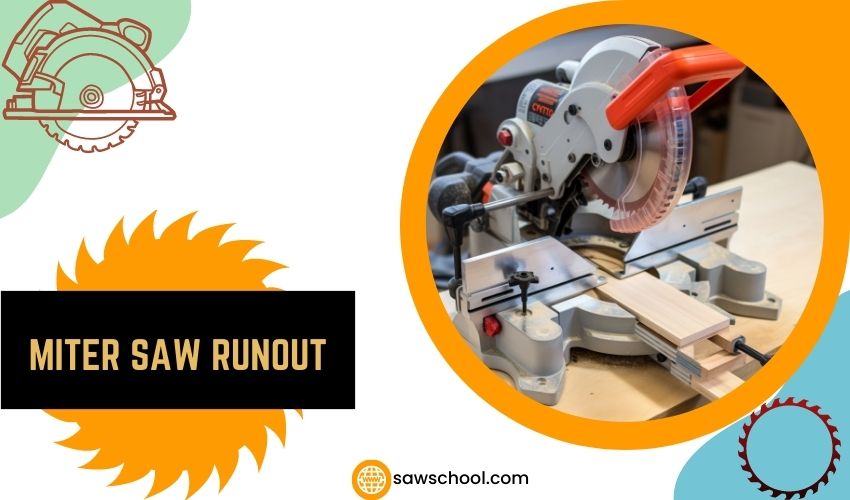It’s not uncommon for miter saw users to come across measurement inaccuracies. But when the miter saw runout is more than you expect, what are the probable reasons behind it? Most importantly, how can you fix this issue?
Miter saw runouts can be caused by a warped or bent blade. Sometimes the arbor washer can be damaged or uneven. If you can find the issue and fix it at its source, the runout can be reduced to a minimum level.
If you want to learn how you can minimize the runout of your miter saw make sure to go through the entire article.

The Gold Standard: What to Expect for Miter Saw Runout
The runout measurement refers to the deviation of the accuracy of the miter saw blade. In simpler words, an ideal blade would spin in a completely circular motion. However, the deviancy created in different places of the blade creates runout, which refers to the level of inaccuracy in a miter saw.
The standard runout depends on what you are doing with your miter saw. Everyone has set a minimum level of accuracy they can tolerate in their work. For instance, if you are doing DIY projects or framings, the inaccuracies will not matter that much.
However, precision woodworking requires the miter saw to be more accurate. An ideal runout measurement for precision work will be less than 0.005. Industrial miter saws are much more precise than this level.
Again, the standard level is most of the set by the user, depending on what they’re doing and how much inaccuracy they are willing to tolerate.
Getting to the Source: Exploring the Causes of Miter Saw Runout
When someone refers to a miter saw runout, it usually means the blade runout. So, the primary reason for causinga runout is the blade. The blade might be bent, warped, or simply not mounted the right way.
If you have mounted the blade too loosely, it can cause a runout. A damaged or bent blade is another common reason to cause a runout. However, there can be other reasons besides the blade.
For instance, the washer attached to the blade might not be set properly or damaged in some way. This can cause the blade to spin unevenly, causing a runout. You can also check my article on miter saw blade is not centered on throat plate if you are interested.
How to Successfully Fix Miter Saw Runout (Cutting with Confidence)
The first thing to do is change the blade. If you see improvement, that means the previous blade was damaged or bent. Before fixing any other part of the miter saw, you have to make sure that the blade is even and accurate.
If you see no change after changing the blade, check the washer. If that’s not damaged either, there’s a high possibility that you haven’t installed the blade correctly.
Different miter saw models require the blade to be installed in a different way. So, you have to go through the specific instructions for a particular miter saw before installing a new blade.
The type of miter saw you are using also determines the level of accuracy you will get. If you’ve got a DIY miter saw for home projects, you can’t expect it to be extremely accurate in measurement. Industrial miter saws, on the other hand, are expected to deliver an extremely high level of accuracy.
Calibrating the miter saw is a crucial step if you want to avoid runouts. If you have any confusion about how to do it properly, check this article from Pro Tool Reviews.
Sometimes, simply cleaning the blade can give you an improved result on the runout. So, if you have been using the blade for quite some time, make sure to remove all the buildup and get a measurement of the runout.
Last but not least, invest in a high-quality dial indicator so that the measurement is as precise as possible. It may cost you a few extra bucks, but the outcome will certainly be worth it.
These are the things you can do by yourself. Remember that you will always have the option of taking the miter saw to a garage for servicing. If you can’t make the miter saw accurate enough, and it’s not an option to invest in a new miter saw right now, visiting the garage might be the best idea for you.
Some Tips To Remember

- If you are making DIY cuts with a miter saw, the runout won’t matter much. All miter saws have a standard level of accuracy that’s suitable for projects that do not require high-precision cuts.
- Always go through the user manual after getting a new miter saw. It can solve more problems than you can imagine. This includes precise instructions on how to install a blade properly. So, the more perfectly you follow the instructions, the more accurate your miter saw will be.
- It’s a good idea to invest in a high-quality industry-level miter saw if you are searching for a unit to do precision cuts.
- Using the same blade for too long will interfere with the accuracy due to residue buildup and damage. So, make sure you’re changing the blade frequently enough, depending on how much you’re working your miter saw.
- Regular maintenance will increase the life of your miter saw. It will also help keep the error to a minimum.
Frequently Asked Questions

Why is my miter saw not cutting straight?
Apart from miter saw runout, there can be multiple reasons why you may not be getting straight and clean cuts. For starters, the fence and blade may not be aligned properly. Faulty calibration and a warped blade can also cause the cuts to be inaccurate.
So, make sure that the fence is accurately aligned, the bevel is in the correct position, and the blade is not damaged in any way.
What is the maximum allowed runout for a miter saw?
Typically, the maximum tolerated level of runout is 0.005 or less. Nonetheless, as I have mentioned before, it entirely depends on the user and what cuts they require with their miter saws. So, it’s not a fixed number.
Closing Thoughts
Miter saw runout is not something cheerful to deal with. But with the right steps and tools, you can minimize the inaccuracy level as much as possible. When you are dealing with high-precision woodwork, inaccuracy is not something you can accept.
However, if you are dealing with DIY projects or framing, it may not be such a big issue. The inaccuracies won’t affect the outcome as much.
